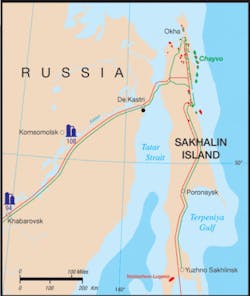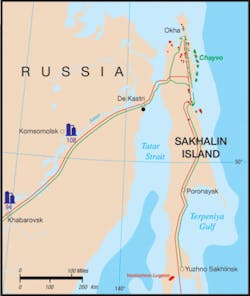DRILLING & PRODUCTION
Frank Hartley, Houston
Sakhalin Island ERD well breaks record
Exxon Mobil Corp. subsidiary Exxon Neftegas Ltd. applied Baker Hughes Inteq’s AutoTrak rotary steerable system to achieve a record extended reach drilling (ERD) well on the Sakhalin-1 project. ExxonMobil reported that the Z-11 well was the longest measured depth extended-reach well in the world.
The record-setting well achieved a total measured depth of 37,016 ft (11,282 m) or over 7 mi. It is the 17th ERD producing well to be completed as part of the Sakhalin-1 project.
The multi-phase Sakhalin-1 project includes the Chayvo field, which lies 8-11 km (5-7 mi) offshore. The Chayvo field reached its peak production rate of 250,000 b/d in February 2007 after an on-schedule startup in October 2005.
Since the first Sakhalin-1 well was drilled in 2003, the time required to drill these wells has been reduced by more than 50%. When compared to industry benchmarks, Sakhalin-1 wells are the world’s fastest drilled ERD wells, ExxonMobil says.
Aluminum pneumatic actuators
Apollo Valve distributors has developed a new pneumatic actuator with an extruded aluminum body and a twin rack-and-pinion design that the company says delivers constant torque output over >500,000 cycles.
The actuators are matched to the operation of the Apollo ball valves and butterfly valves. They feature inboard and outboard travel stops for easy stroke adjustment. The actuators are designed for a wide range of applications including industrial, commercial, petrochemicals, pharmaceuticals, automotive, and food and beverage, Apollo says.
The body of the valve is hard-coat anodized to resist wear and corrosion. Bore finishing minimizes friction and wear, and nickel-plated steel pinions resist internal and external corrosion.
Stainless steel assembling screws and die cast aluminum end caps and pistons increase the life of the actuators, which are pre-lubricated for the life of the assembled unit, Apollo says.
Baker Hughes, JLC Technologies sign agreement
Baker Hughes Drilling Fluids has signed a license agreement with JLC Technologies, LLC. of Tyler, Texas, concerning technology for produced water management and other fluid treatment applications for the oil and gas industry worldwide.
Baker Hughes will market and manage services applying JLC Technology’s filtration system, expanding the capabilities of its Fluids Environmental Services line. This technology can be used with produced water and other oil and gas industry fluids, Baker says.
Aluminum could extend drilling reach
A Russian consortium wants to promote lightweight aluminum drill pipes to facilitate extended reach drilling in remote regions.
Moscow-based Aquatic Co. and the Kamensk-Uralsky Metallurgical Works have supplied aluminum drilling risers for some time to Noble Drilling. Aquatic also has worked with Weatherford to harness aluminum drillpipes for use in ultra-long sections in extended reach wells beyond the current stress limits of conventional steel tubulars.
According to a presentation at OTC, prime candidates could be regions such as Alaska and Sakhalin Island, which for much of the year are ice-bound, necessitating drilling of offshore development wells from the coast. However, operators in more clement regions, notably Saudi Aramco and Petrobras, have also expressed interest.
Hydro secures directional drilling services
In early May, Hydro issued framework agreements to three companies for advanced well steering services and equipment. The contracts, with a total value of around $116.45 million, relate mainly to the Brage, Grane, Oseberg, and Troll field developments in the Norwegian North Sea.
Baker Oil Tools, Schlumberger, and WellDynamics will provide equipment suitable for steering multilaterals and single bore wells covering several zones. Hydro says it wants to extend its experience with advanced zone steering on Troll, where it has drilled wells with six branches, to all its Norwegian fields.
WellDynamics’ contract relates to Brage, Grane, and Oseberg, while the other two contractors secured agreements for Troll. The remainder of the overall contract value is connected with deliveries to smaller fields. All of the agreements have a two-year duration, with optional extensions of up to six years.
Subsurface control valve aids abandonment
Halliburton’s subsurface control valve III (SSC III) allows up to a million pounds of drill string to hang off it in order to secure the rig and evacuate personnel when the threat of a hurricane arises, the company says.
The subsurface control valves have controlled more than three-quarters of the wells being drilled in the Gulf of Mexico during the 2005 Katrina and Rita hurricanes, Halliburton says.
During a threat, securing the rig can involve having to undo days of work because the downhole string weight has to be reduced, which involves tripping drill pipe and wasting rig time.
In deepwater, the cost to secure a well when pulling the string can quickly reach nearly $1 million. The tubing can be secured by a pressure test of up to 1,000 psi conducted from the surface, which results in increased well security and minimizes casing damage.
The SSC III allows operators to secure the string downhole with its million-pound hang-off capacity, providing efficient abandonment of the drilling rig. Also, because the string is left in place, minimal effort is required to get back online when the emergency has passed.

